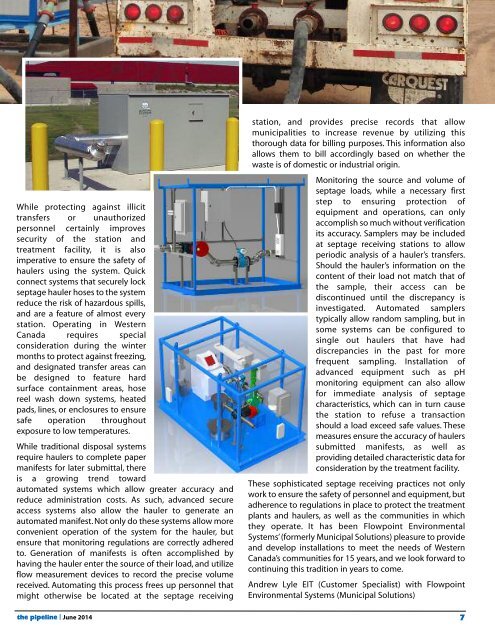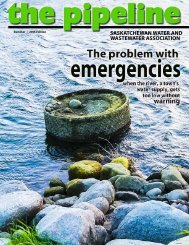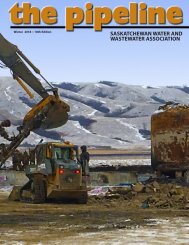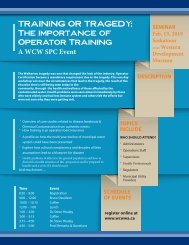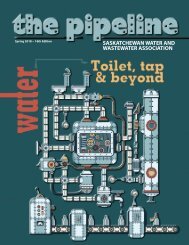2014 JUNE PIpeline
You also want an ePaper? Increase the reach of your titles
YUMPU automatically turns print PDFs into web optimized ePapers that Google loves.
While protecting against illicit<br />
transfers or unauthorized<br />
personnel certainly improves<br />
security of the station and<br />
treatment facility, it is also<br />
imperative to ensure the safety of<br />
haulers using the system. Quick<br />
connect systems that securely lock<br />
septage hauler hoses to the system<br />
reduce the risk of hazardous spills,<br />
and are a feature of almost every<br />
station. Operating in Western<br />
Canada requires special<br />
consideration during the winter<br />
months to protect against freezing,<br />
and designated transfer areas can<br />
be designed to feature hard<br />
surface containment areas, hose<br />
reel wash down systems, heated<br />
pads, lines, or enclosures to ensure<br />
safe operation throughout<br />
exposure to low temperatures.<br />
While traditional disposal systems<br />
require haulers to complete paper<br />
manifests for later submittal, there<br />
is a growing trend toward<br />
automated systems which allow greater accuracy and<br />
reduce administration costs. As such, advanced secure<br />
access systems also allow the hauler to generate an<br />
automated manifest. Not only do these systems allow more<br />
convenient operation of the system for the hauler, but<br />
ensure that monitoring regulations are correctly adhered<br />
to. Generation of manifests is often accomplished by<br />
having the hauler enter the source of their load, and utilize<br />
flow measurement devices to record the precise volume<br />
received. Automating this process frees up personnel that<br />
might otherwise be located at the septage receiving<br />
station, and provides precise records that allow<br />
municipalities to increase revenue by utilizing this<br />
thorough data for billing purposes. This information also<br />
allows them to bill accordingly based on whether the<br />
waste is of domestic or industrial origin.<br />
Monitoring the source and volume of<br />
septage loads, while a necessary first<br />
step to ensuring protection of<br />
equipment and operations, can only<br />
accomplish so much without verification<br />
its accuracy. Samplers may be included<br />
at septage receiving stations to allow<br />
periodic analysis of a hauler’s transfers.<br />
Should the hauler’s information on the<br />
content of their load not match that of<br />
the sample, their access can be<br />
discontinued until the discrepancy is<br />
investigated. Automated samplers<br />
typically allow random sampling, but in<br />
some systems can be configured to<br />
single out haulers that have had<br />
discrepancies in the past for more<br />
frequent sampling. Installation of<br />
advanced equipment such as pH<br />
monitoring equipment can also allow<br />
for immediate analysis of septage<br />
characteristics, which can in turn cause<br />
the station to refuse a transaction<br />
should a load exceed safe values. These<br />
measures ensure the accuracy of haulers<br />
submitted manifests, as well as<br />
providing detailed characteristic data for<br />
consideration by the treatment facility.<br />
These sophisticated septage receiving practices not only<br />
work to ensure the safety of personnel and equipment, but<br />
adherence to regulations in place to protect the treatment<br />
plants and haulers, as well as the communities in which<br />
they operate. It has been Flowpoint Environmental<br />
Systems’ (formerly Municipal Solutions) pleasure to provide<br />
and develop installations to meet the needs of Western<br />
Canada’s communities for 15 years, and we look forward to<br />
continuing this tradition in years to come.<br />
Andrew Lyle EIT (Customer Specialist) with Flowpoint<br />
Environmental Systems (Municipal Solutions)<br />
the pipeline | June <strong>2014</strong> 7


